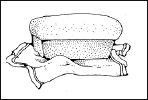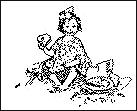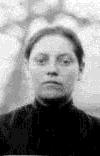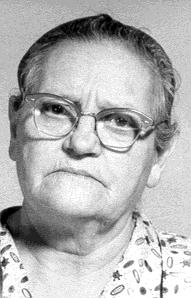"Brot Tag"
"Bread Day"
Plus, POTATO BREAD Recipe
in
THOSE WERE THE DAYS
in Montana in the mid 1920s - 1930s
by Lillian Hein Remmick
Copyrighted 1991
All rights are reserved. This book, or parts thereof, may not be reproduced in any form without permission. Published by Remick-Hubert Corp.221 Main Streeet, Suite 1300, San Francisco, California, 94105.
In summer it was also often served with watermelon and muskmelon. Mother would slice a platter of bread and a very large platter of melon and we would alternate bites of bread with bites of melon. This was a custom they brought with them from Russia and we never questioned why it was so served.
Her bread was always made with everlasting yeast. A yeast which was carefully kept from baking to baking. How was this yeast started? I really don't know as it was a precious commodity and if a women accidentally lost her everlasting yeast there was always a neighbor who would gladly share.
According to history women carried their everlasting yeast across country in wagon trains and if necessary would even take it to bed with them so their body heat would keep the yeast from freezing in very cold weather.
My sister-in-law told me that their house in winter would be very cold at night so her Mother would cover her sponge with a clean towel and then her Father's sheep skin coat to keep it warm.
One old Montana rancher put it this way, "Dough starter in those days was so precious one would protect it with a gun."
When I was young there wasn't any dry yeast to buy as it hadn't been perfected. Cakes of Fleishmans yeast were available in local bakeries, however, in some instances the bakery was maybe fifty miles away.
Mother would boil potatoes for supper and save the potato water for bread making.
After supper she would bring out her bread baking bowl which to me as a child seemed monstrous. It was made of a shinny metal and had a hollow metal stand.
Into this bowl would go the potato water (that had earlier been poured off of the boiled potatoes that same evening), sugar, the jar of everlasting yeast, and, enough flour to make a light sponge. This was beaten with a large metal spoon until it was light and bubbly. This she would cover and set aside in a warm place until morning.
After breakfast the next morning she would remove enough sponge to fill the jar. This would be the new everlasting yeast for the next bread baking.
To the bowl she added salt, lard and flour. Then she placed the bowl on a chair and she would knead the dough with vigor until it was smooth and very elastic.
Then she'd take a bit of lard in her right hand and grease the inside of the dough bowl. Then a bit more lard was rubbed between her hands to pat the dough into a large round ball. The dough was covered and set in a warm place to rise.
Mother never measured these items by cup or spoon. She simply measured by eye sight, hand and flour sifter.
Around 10:30 a.m. she would knead the dough for the first time and then taking dough the size of a walnut would roll it between her hands until elongated and pointed on each end which she would place on a floured area leaving space in between for the "dumpfennudel" to rise.
If winter time you'd probably would smell at this time the sauerkraut from the crock in the cellar and goose shanks from the smoke house simmering on the wood and coal kitchen range.
About eleven o'clock Mother would bring out her large steel roaster with the hollow bottom and doomed lid. Into this would go peeled cut potatoes, pepper, lard, salt and just enough water to cover potatoes. When potatoes would be boiling , she would carefully place raised dumpfennudel over the potatoes, cover and place weights on the lid (usually a couple of old flat-irons). Heaven help the soul who'd dare lift the lid to take a peek before my Mother declared them done which usually took twenty to thirty minutes.
When the dough in the bowl was again double in size she would knead it down, and when again doubled in size made it up into bread loaves.
With greased hands she would pat and pinch dough into beautiful loaves and place them in greased pans to rise. Then they were baked to a golden brown in the oven of the wood and coal range.
What dinners they would be!
In the summer it would be served with young farm fried chicken , chicken gravy, crispy potatoes, dumpfennudel and salad made from early leaf lettuce over which she served her special dressing made of finely chopped new onion greens, buttermilk, cream, vinegar, salt and pepper.
In winter it would be sauerkraut with smoked goose, crisped potatoes and dumpfennudel that were as light as a feather.
The aroma was heavenly.
My husband says that he and the other city kids usually spread their fresh bread with peanut butter that had been mixed with [dark corn] syrup. He still loves fresh bread this way accept now he adds a lot of farm fresh butter on it before the peanut butter mixture.
After much trial and error I came up with a recipe which tastes and looks like Mother's bread and also fits our modern day.
The following recipe will make two large loaves of bread using 3x5x9 inch pans,
Or, one large loaf and about thirty dumpfennudel,
Or, fifteen dumfennudel and the remaining dough cut in half makes two nice loaves using 3x4x8 inch pans.
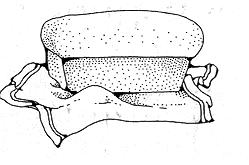
1 medium potato
2 cups water
1 tablespoon sugar
1 tablespoon salt
3 tablespoon oil
2 packages of dry yeast
6 cups unbleached white flour [organic if you can find it]
Depending on the kind of flour used you may need to add more flour then listed above.
(1) Boil cut up potato in two cups of water until potato is very soft
note: I Do Not use aluminum pan for boiling potatoes
(2) Drain liquid and set the liquid aside to cool
(3) Place potatoes in a large stainless steel kitchen aid bowl [4 quart size] and attach wire whip and beat potato well.
(4) Now add two cups cooled to luke warm potato water [if necessary add more water to make two cups) with sugar, salt, oil, yeast and three cups flour
(5) Beat on very low speed until blinded then
(6) Beat on medium speed for one minute [can beat longer]
(7) Let mixture rest for 5 to 10 minutes
(8) Change wire whip to dough hook and add 3 more cups of flour
(9) Knead dough about ten minutes on very low speed
(10) More flour made be added if necessary at this time if needed
(11) Dough is right if it leaves sides of bowl and cling to dough hook
(12) Remove dough from bowl and grease inside of bowl and pat dough with it with the flat of your hands and shape it into a round ball, place back in bowl, cover and place the bowl in a warm place so the dough will rise
When the dough is doubled in bulk place on floured board and knead gently and make up into loaves or dumpfennudel.
When loaves are double in size bake.
If using a metal pan bake in preheated oven at 400 degrees. If using glass the heat should be 375 degrees.
Bake for thirty five minutes or until dark golden brown.
For dumpfennudel follow directions as described earlier in my story.
This bread freezes well.
1903 Pict taken about 1903 in Borodino / Bessarabia, S. Russia |
Christina, nee Schweikert, Hein., dau. of Karl and Katrina, nee Henke, Schweikert, and wife of Ludwig Hein |
1960 Pict. taken early 1960s in Lodi, CA, USA 1885-1982 |
Bless them all.
![]()
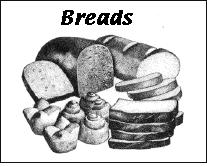
MT Home Site
